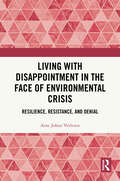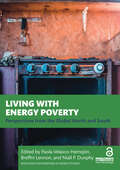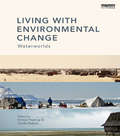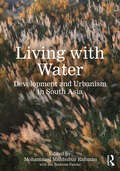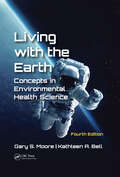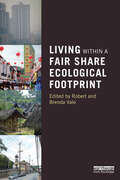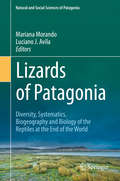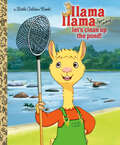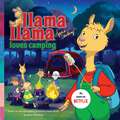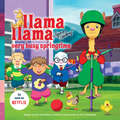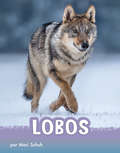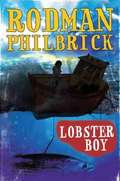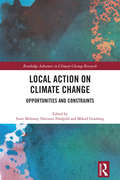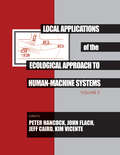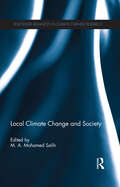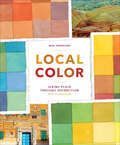- Table View
- List View
Living with Disappointment in the Face of Environmental Crisis: Resilience, Resistance, and Denial
by Arne Johan VetlesenWhile the impacts of climate change become increasingly severe, efforts to prevent them suffer one blow after the other, as seen in the rise of far-right populist parties in Western democracies. Why does denialism thrive when blatantly contradicted by the realities before our very eyes, be it wild-fires, floods, drought, and melting glaciers? Should we abandon the assumption that the more solid the knowledge about climate change, the more eager will ordinary people as well as political leaders be to take action?This book sets out to explain the contradiction witnessed between knowledge and action. Inspired by Clive Hamilton’s claim that “denial is due to a surplus of culture rather than a deficit of information”, the book critiques the focus on “cognitive disso-nance” in individual agents advocated by climate psychology as well as the individualistic bias in liberal political theory. To get out of the current theoretical as well as political impasse, the author suggests three moves are necessary: from knowledge to first-hand experience, and so to feelings; from the tension within the individual to the social organization of denial; and from the obsession with personal responsibility – nowadays in the guise of building resilience – to exposing the complicity of the culture of neoliberalism in the intimately intertwined crisis of politics and the climate alike.A highly timely and sharp analysis of the roots of inaction and denial and possible strategies for resistance, the book will appeal to scholars and upper-level students with interests in social, political, and environmental philosophy and psychology; political theory; and environmental studies.
Living with Energy Poverty: Perspectives from the Global North and South (Routledge Explorations in Energy Studies)
by Paola Velasco-Herrejón Breffní Lennon Niall P. DunphyLiving with Energy Poverty: Perspectives from the Global North and South expands our collective understanding of energy poverty and deepens our recognition of the phenomenon by engaging with the lived experiences of energy-poor households across different contexts.Understanding the lived experience of energy poverty is an essential component in the design of any effort to alleviate what is fundamentally a deep-rooted, multi-faceted, wickedly complex problem. This requires a nuanced understanding of the causal factors and the research methods that can respond to the flexible spatial and temporal nature of the condition, as well as its wellbeing and justice implications. Drawing together the expertise and connectedness of authors from the Global South and North, this book presents novel approaches to understanding the often hidden forms of domestic energy deprivation. Case studies from 20 countries provide critical perspectives on this phenomenon while analysing the policy practices, government strategy, and sustainability implications of divergent manifestations. The book takes a multidimensional perspective, challenging the bias towards energy production and service provision, which often do not align with the aspirations and realities of energy households across global contexts, thus facilitating a useful dialogue on the nature of energy poverty.The book is a timely source for policymakers, practitioners, and scholars seeking fresh, diverse insights into the everyday reality of energy poverty and wanting to better understand the challenges a people-centred, just energy transition can present.Chapter 1 of this book is freely available as a downloadable Open Access PDF at http://www.taylorfrancis.com under a Creative Commons [Attribution-Non Commercial-No Derivatives (CC-BY-NC-ND)] 4.0 license.Chapter 2 of this book is freely available as a downloadable Open Access PDF at http://www.taylorfrancis.com under a Creative Commons [Attribution-Non Commercial-No Derivatives (CC-BY-NC-ND)] 4.0 license.Chapter 22 of this book is freely available as a downloadable Open Access PDF at http://www.taylorfrancis.com under a Creative Commons [Attribution-Non Commercial-No Derivatives (CC-BY-NC-ND)] 4.0 license.
Living with Environmental Change: Waterworlds
by Kirsten Hastrup Cecilie RubowClimate change is a lived experience of changes in the environment, often destroying conventional forms of subsistence and production, creating new patterns of movement and connection, and transforming people’s imagined future. This book explores how people across the world think about environmental change and how they act upon the perception of past, present and future opportunities. Drawing on the ethnographic fieldwork of expert authors, it sheds new light on the human experience of and social response to climate change by taking us from the Arctic to the Pacific, from the Southeast Indian Coastal zone to the West-African dry-lands and deserts, as well as to Peruvian mountain communities and cities. Divided into four thematic parts - Water, Landscape, Technology, Time – this book uses rich photographic material to accompany the short texts and reflections in order to bring to life the human ingenuity and social responsibility of people in the face of new uncertainties. In an era of melting glaciers, drying lands, and rising seas, it shows how it is part and parcel of human life to take responsibility for the social community and take creative action on the basis of a localized understanding of the environment. This highly original contribution to the anthropological study of climate change is a must-read for all those wanting to understand better what climate change means on the ground and interested in a sustainable future for the Earth.
Living with Water: Development and Urbanism in South Asia
by Mohammed Mahbubur Rahman Md. Nawrose FatemiLiving with Water explores the perennial, dynamic relationship between water and the built environment in South Asia. This interdisciplinary survey of the unique urban and ecological landscapes of the region presents a diverse selection of cities and projects, and offers practical, contextual strategies for the design and protection of these sites against emergent impacts of climate change and population growth. Water resources in South Asia are some of the most vulnerable to the effects of global warming. In the many historic urban centres that have grown over time along the rivers and waterfronts of the region, deteriorating water systems and rapid population expansion have contributed to problems such as water insecurity, exposure of built structures to weather damage, floods, and erosion. Case studies drawn from Bangladesh, India, Pakistan, and Sri Lanka illustrate a range of contemporary and traditional approaches to living with water within the ecosystems, floodplains, wetlands, waterfronts, river systems, and water networks of the region. Chapters authored by architects, planners, historians, sociologists, geographers, and environmentalists combine insights into analytical methods and processes of urban planning and development, with critical attention to the importance of cultural heritage, vernacular construction, traditional water systems, and indigenous knowledge in shaping climate-resilient built and natural environments. This context supports resilient ecology and a sustainable approach to building and resource management, offering guidance in the creation of water-sensitive development, integrated urban design, wetlands restoration, and more. Living with Water is an essential read for researchers and professionals in architecture, urban planning, water management, environmental conservation, real estate development, tourism, and local governance, and will appeal to broad range of readers interested in the history, geography, and culture of South Asia.
Living with Wood: A Guide for Toymakers, Hobbyists, Crafters, and Parents
by Dr. Seri C. RobinsonA comprehensive guide for wood workers of all ages that covers the science behind wood, its many uses, and optimal care. For anyone who has ever used, owned, or been curious about wood of any kind, this guide offers a fantastic summary of the science behind the material&’s anatomy, chemistry, and general upkeep. With the practical and accessible information presented here, you&’ll never have difficulty deciding what wood to work with or how to clean your boarded floors again. Living with Wood covers a broad range of topics, including best uses of wood in the home, finishing and coloring, woodworking machines, and unsafe woods. Whether you&’re building furniture, getting crafting, or caring for wooden antiques, this is your ideal guide to the most versatile, reliable, and beautiful material ever known.
Living with the Earth, Fourth Edition: Concepts in Environmental Health Science
by Gary S. Moore Kathleen A. BellShelving Guide; Environmental ScienceThis is a groundbreaking and innovative book now in its fourth edition. The first edition won the CHOICE award for outstanding Academic Book while editions two and three became bestsellers on their own right. This fourth edition is packed with new updates on current world events associated with environmental issues and related health concerns. The author maintains traditional concepts and merges them with new and controversial issues. The book has been revised to include up-to-date topics with and a revised Web site with updated links.So what Coverage of emergency preparedness for environmental health practitioners Discussion of population dynamics especially with regard to overpopulation and underpopulation around the world and their respective influences on social, economic, and environmental concerns. The mechanisms of environmental disease, emphasizing genetic disease and its role in developmental disorders and cancer. Human behaviors and pollution are presented along with respect to their roles in cancer risk. The ever increasing issues surrounding emerging and re-emerging diseases around the earth and the introduction of an increasing number of emerging diseases. The growing problems of asthma and other health effects associated with air pollution. An exploration of the mechanisms of toxicity with special reference to the immune system and endocrine disruption. The ongoing issues of the creation and disposal of hazardous waste along with the controversies surrounding disposal are presented. The issues and benefits of recycling are explored. The use of HACCP in assuring food quality, food safety issues, and the Food Quality Protection Act are discussed. Numerous technical illustrations, charts, graphs, and photographs are included What on the Web? Test bank and study questions giving a complete review of the concepts covered. Search tools for online journals and databases covering useful, up-to-date information in health and environmental topics Subject specific links by chapter as well as Federal, state, and organization sites with relevant information Downloadable PowerPoint files for each Chapter providing the instructor with ready-made presentation materials that can be modified as needed. Downloadable and printable test questions and answers for each chapter available to instructors
Living within a Fair Share Ecological Footprint
by Robert Vale Brenda ValeAccording to many authorities the impact of humanity on the earth is already overshooting the earth’s capacity to supply humanity’s needs. This is an unsustainable position. This book does not focus on the problem but on the solution, by showing what it is like to live within a fair earth share ecological footprint. The authors describe numerical methods used to calculate this, concentrating on low or no cost behaviour change, rather than on potentially expensive technological innovation. They show what people need to do now in regions where their current lifestyle means they are living beyond their ecological means, such as in Europe, North America and Australasia. The calculations focus on outcomes rather than on detailed discussion of the methods used. The main objective is to show that living with a reduced ecological footprint is both possible and not so very different from the way most people currently live in the west. The book clearly demonstrates that change in behaviour now will avoid some very challenging problems in the future. The emphasis is on workable, practical and sustainable solutions based on quantified research, rather than on generalities about overall problems facing humanity.
Lizards of Patagonia: Diversity, Systematics, Biogeography and Biology of the Reptiles at the End of the World (Natural and Social Sciences of Patagonia)
by Mariana Morando Luciano J. AvilaThis book presents a critical and integrated review of lizards from Patagonia. It summarizes the region’s geomorphological history and climatic aspects, which makes it possible to interpret, from an evolutionary perspective, the latest findings on the various natural history aspects of its lizard fauna. As such, the book will appeal to all researchers and professionals specialized in lizard ecology and evolution.
Lizards of the World: A Guide to Every Family
by Mark O'SheaA lavishly illustrated overview of the world’s lizardsLizards are one of nature’s great success stories: survivors from the time of the dinosaurs, they have taken advantage of almost every habitat on earth, from tropical rainforest to Arctic tundra and even our homes. From chameleons and skinks to geckos and iguanas, there are close to 7,000 species of lizards around the world. This expert guide explores their extraordinary diversity and adaptations.Lizards of the World features an in-depth introduction covering the evolution, anatomy, and lifestyle of lizards, followed by profiles of species from every family, accompanied by stunning color photographs. This invaluable guide highlights the enormous range of habitats, appearance, and activity among lizards. Many thrive in extreme conditions, and have adapted to keep cool, warm, or hydrated. Some can protect themselves by changing color to blend in with their surroundings, while others have fringed toes enabling them to run across sand, or can parachute out of a predator’s reach. Covering diet and reproduction as well as defense strategies and conservation, Lizards of the World showcases the unique natural history and beauty of these remarkable creatures.More than 200 detailed photographic images80+ lizard families and subfamiliesExploration of lizard biology, behavior, habits, and distributionBroad coverage and in-depth treatment by a world-renowned herpetologist
Lizzie!
by Maxine Kumin Elliott Gilbert<P>Lizzie, age eleven, does not let her wheelchair get in the way of her curiosity. After she is partially paralyzed in a diving accident, Lizzie and her single mom are starting life over in a small town in Florida, where Lizzie's thirst for knowledge and adventure makes her some unlikely friends and gets her into some sticky situations. <P>Resilient and precocious, Lizzie has a passion for learning new words (especially those with Latin roots) and a propensity for finding trouble, which is how she ends up stumbling upon criminal activities involving seedy characters, beautiful golden monkeys, and murder. A man with a slick grin arrives on the scene, and Lizzie begins to uncover where the monkeys came from. With Josh and Digger's help, she puts the pieces together, but it's too late, the monkey thief strikes again and this time, it's Lizzie who's in danger.
Llama Llama Let's Clean Up the Pond! (Little Golden Book)
by Anna DewdneyA Little Golden Book based on the Llama Llama animated series on Netflix! The beloved character Llama Llama stars in this new Little Golden Book based on his own original series, now airing on Netflix. Inspired by the bestselling picturebooks created by Anna Dewdney, this reassuring story features Llama rallying the town to clean up the pond in time for the annual boat float. Llama Llama and his friends learn about art, community, and celebrating nature in this environmental tale.
Llama Llama Loves Camping (Llama Llama)
by Anna DewdneyBased on an episode of Llama Llama's animated Netflix series, this book is all about one of the most fun activities for little llamas (and kids): camping!Look out, world--Llama Llama is a TV star! The beloved character, made famous by Anna Dewdney's best-selling picture books, is the star of his own original series, now airing on Netflix. In this episode-based 8x8, Llama Llama goes camping for the very first time and learns a valuable lesson: what seems scary can actually be super-duper FUN! Your little llamas will love relating to their favorite picture book character as he faces new and challenging situations.
Llama Llama Very Busy Springtime (Llama Llama)
by Anna DewdneyIt's springtime in this paperback picture book based on an episode of the animated Llama Llama Netflix series, perfect for fans of Llama Llama Loves Camping looking for more fun adventures with their favorite characters.Look out, world—Llama Llama is a TV star! The beloved character, made famous by Anna Dewdney's best-selling picture books, is the star of his own original series, now airing on Netflix. In this episode-based story, Llama Llama plans a bit too much for one day, but comes up with a solution and learns important lessons along the way. Your little llamas will love relating to their favorite picture book character as he faces new and challenging situations.
Llama Pajamas
by Susan ClymerSarah has to leave her beloved computer to go on a mountain trek with her parents and two huge llamas, but she soon gets into the spirit of the trip.
Lo que comemos: Antes y ahora (¡Arriba la Lectura!, Level Q #35)
by Debbie CroftEn el pasado, la gente debía producir y preparar casi todo lo que comía. Solo podía comprar productos que se encontraban localmente. Hoy día, los avances en el transporte y la tecnología nos permiten disfrutar alimentos de todo el mundo. NIMAC-sourced textbook
Lobos (Animals en espanol)
by Mari SchuhCon sus espeluznantes aullidos y su feroz habilidad para la caza, los lobos son criaturas fascinantes. Viven en manadas y son parientes cercanos del mejor amigo del hombre, el perro. Aprende ma´s sobre estos magni´ficos cazadores.
Lobster Boy
by Rodman Philbrick12-year-old Samuel `Skiff' Beaman is a boy with incredible determination in the face of adversity. Since the death of his mother, his father has sunk into an alcoholic depression, and now Skiff's pride and joy, their boat the Mary Rose has sunk too. If only he can raise and fix Rose, Skiff is sure he'll be able to get the family business, and his dad, back on track. But to fix the boat he needs $5000. With his father penniless and hopeless, Skiff is determined to raise the money himself - by going out on the open ocean all alone, on a dangerous mission to harpoon a prize giant tuna.
Local Action on Climate Change: Opportunities and Constraints (Routledge Advances in Climate Change Research)
by Susie Moloney Hartmut Fünfgeld Mikael GranbergThere is growing interest in analysing the role and effectiveness of the local scale in responding to the global challenge of climate change. However, while accounts of urban climate change governance are growing, there is now a real need for further conceptual and empirical work to better understand processes of change and uptake across a range of climate change actions. Local Action on Climate Change examines how local climate change responses are emerging, being operationalized and evaluated within a range of geographical and socio-political contexts across the globe. Focussing on the role and potential of local governments, non-government organisations and community groups in driving transformative change, the authors analyse how local climate change responses have emerged and explore the extent to which they are or have the potential to be innovative or transformative in terms of governance, policy and practice change. Drawing on a diverse range of case studies, including examples from Vanuatu, Japan, South Africa, Australia, Sweden, the USA and India, this volume will be of great interest to students and scholars of climate change, environmental policy and governance, and sustainability.
Local Activism for Global Climate Justice: The Great Lakes Watershed (Routledge Advances in Climate Change Research)
by Patricia E. PerkinsThis book will inspire and spark grassroots action to address the inequitable impacts of climate change, by showing how this can be tackled and the many benefits of doing so. With contributions from climate activists and engaged young authors, this volume explores the many ways in which people are proactively working to advance climate justice. The book pays special attention to Canada and the Great Lakes watershed, showing how the effects of climate change span local, regional, and global scales through the impact of extreme weather events such as floods and droughts, with related economic and social effects that cross political jurisdictions. Examining examples of local-level activism that include organizing for climate-resilient and equitable communities, the dynamic leadership of Indigenous peoples (especially women) for water and land protection, and diaspora networking, Local Activism for Global Climate Justice also provides theoretical perspectives on how individual action relates to broader social and political processes. Showcasing a diverse range of inspirational and thought-provoking case studies, this book will be of great interest to students and scholars of climate justice, climate change policy, climate ethics, and global environmental governance, as well as teachers and climate activists.
Local Air Quality Control and Health: Theory and Practice (Routledge Focus on Environmental Health)
by Mark Hardwick Nahum Kidan Nathaniel Smith Steve ManningThis highly accessible book identifies the major air pollutants which cause human health concerns and examines the sources of these pollutants. With a focus on NOx gases, particulate matter (PM), tropospheric ozone, and volatile organic compounds (VOCs), Part 1 covers the theory and relates these pollutants to specific health outcomes by examining the nature of anatomical/physiological systems which are affected and the mechanisms by which these effects take place.Part 2 explores the legal and policy frameworks that govern local air quality management in the UK. It examines the responsibilities and powers of regulators, the role of national and international legislation, and how law and guidance are used to protect public health and improve environmental outcomes. Part 3 outlines the role of environmental health practitioners (EHPs) in dealing with local air quality management for communities before the applications used to control pollution are discussed, both in terms of using the law effectively and technological interventions which can trap air pollution at source.The book is principally aimed at undergraduate and/or post graduate students in Environmental Health and Public Health and EHPs practising in the field of air quality control. It will also be relevant to students of environmental sciences, health sciences, medicine and environmental law and policy.
Local Applications of the Ecological Approach To Human-Machine Systems (Resources for Ecological Psychology Series)
by Peter Hancock, John Flach, Jeff Caird and Klim VicenteThere is a growing consensus in the human factors/ergonomics community that human factors research has had little impact on significant applied problems. Some have suggested that the problem lies in the fact that much HF/E research has been based on the wrong type of psychology, an information processing view of psychology that is reductionistic and context-free. Ecological psychology offers a viable alternative, presenting a richer view of human behavior that is holistic and contextualized. The papers presented in these two volumes show the conceptual impact that ecological psychology can have on HF/E, as well as presenting a number of specific examples illustrating the ecological approach to human-machine systems. It is the first collection of papers that explicitly draws a connection between these two fields. While work in this area is only just beginning, the evidence available suggests that taking an ecological approach to human factors/ergonomics helps bridge the existing gap between basic research and applied problems.
Local Citizenship in a Global Age
by Kenneth A. StahlAlthough it is usually assumed that only the federal government can confer citizenship, localities often give residents who are noncitizens at the federal level the benefits of local citizenship: access to medical care, education, housing, security, labor and consumer markets, and even voting rights. In this work, Kenneth A. Stahl demonstrates that while the existence of these 'noncitizen citizens' has helped to reconcile competing commitments within liberal democracy to equality and community, the advance of globalization and the rise of nationalist political leaders like Donald Trump has caused local and federal citizenship to clash. For nationalists, localities' flexible approach to citizenship is a Trojan horse undermining state sovereignty from within, while liberals see local citizenship as the antidote to a reactionary ethnic nationalism. This book should be read by anyone who wants to understand why citizenship has become one of the most important issues in national politics today.
Local Climate Change and Society: Local Climate Change And Society (Routledge Advances in Climate Change Research #1)
by M. A. Mohamed SalihAlthough the impacts of climate change are certainly global, its manifestations and subsequent consequences begin locally. Local Climate Change and Society examines how climate change has altered society’s relationship with the environment and particularly local communities to adapt to and mitigate climate change. The book analyzes the principles, practices and local responses to micro-level climate policies and interrogates the increasing role of local governments and local climate social movements induced by transnational corporations’ activities both above and below the equator. This book contains country and cross-country case studies and inter-disciplinary contributions written by academics, researchers and policy makers at the cutting edge of climate change knowledge. It aimed at students of environmental and climate change in the social sciences, academics, climate change public. Local climate change and society has direct appeal to professional staff concerned with environmental management, and policy makers supporting communities and municipalities in climate change adaptation and mitigation processes and activities at the at local level.
Local Climate Governance in China
by Miriam SchröderBased on the empirical analysis of the effectiveness of four provincial centres for the diffusion of the Clean Development Mechanism (CDM), a market mechanism for emission reductions, Miriam Schr#65533;der scrutinizes the strengths and weaknesses of hybrid actors' performance on the local Chinese carbon market.
Local Color: Seeing Place Through Watercolor
by Mimi RobinsonHow to understand color&’s impact on our perception of a place—and capture its palette in watercolor landscapes and cityscapes. Whenever we first encounter a new place, whether landscape or cityscape, one of the most immediate and powerful sensations comes from its colors, or the palette of colors, which profoundly influence our reaction to and sense of a space. In Local Color, designer and educator Mimi Robinson teaches us not only how to see the colors around us but also how to capture and record them in watercolor. Regardless of your level of painting expertise, Robinson will quickly have you creating personal memories of time, place, and travel through a series of self-guided exercises and illustrated examples.
